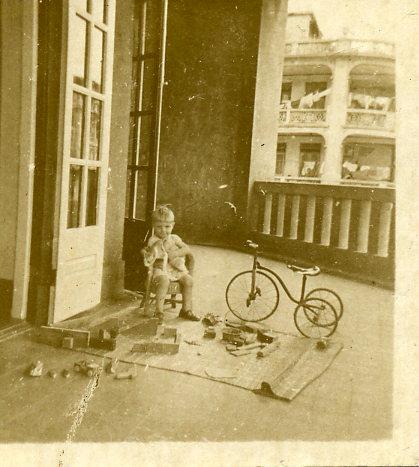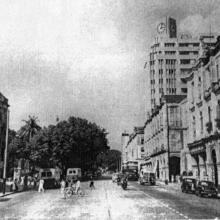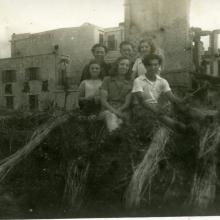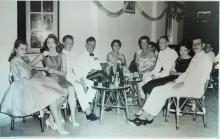First Floor Flat Sham Shui Po Police Station 1946
Primary tabs

Submitted by stepheneroberts
Date picture taken (may be approximate):
Tuesday, January 1, 1946
Gallery:
Connections:
- First Floor Flat Sham Shui Po Police Station 1946 shows Place Sham Shui Po Police Station [1925- ]




Comments
Sham Shui Po Police Station
Stephen: Thanks for showing the photo. It shows the balcony across the street - same spot I was standing in 1957 looking at your former residence.
So you live in Sham Shui Po
So you live in Sham Shui Po Police Station when you are young?
Sham Shui Po Police Station
Hi Phoebe, sorry for the late reply. The photo shows the pre-war shophouse across the street on the northeast corner of the Lai Chi Kok Road and Yen Chow Street intersection. I visited my friend there (Ghan Wei Hon) a few times at level-2 which faces the boy's residence.
One memorable moment in 1957- I was crossing Yen Chow westbound at the same time a man was crossing eastbound. He had a minor collision with a cyclist on Yen Chow Street. The cyclist claimed the man didn't look when crossing and they had a "discussion". The man lift up his shirt to show his sidearm - apparently having just come out of the station. That end the discussion. Regards, Peter
Living At Sham Shui Po
This was my first home in HK, and the cat awas out first. I remember the Army camp just around the corner and the ramp over the water where the rubbish lorries tipped their loads onto barges. Across the road was the Comprador which we used for ten years. Also 2 doors down, Sun Kee Taylors where my school uniforms were made with my brother and sisters, again until 1956. We did not have a car then so trips to Lai Chi Kok amusement Park were by bus. I once walked onto a bus and reached Lai Chi Kok on my own! They traced me onto the bus and found me there. Other memories - seeing fresh live lobsters cooked in the washing boiler, kaolin (from small tins which were heated in a pan of water) poultices for boils which were commonplace, - strange what comes to mind. Across the road were several street markets which had an open nullah running down the middle. My mother took us there regularly, wherever we lived, to shop for cloth which was then taken to Sun Kee Tailors to make into uniforms, dresses for my mother and sister etc, within days.
Amazing
I am delighted, astonished and moved to see this image. This very apartment was also one of my first childhood homes—it's certainly the one I remember most vividly—and I too had a tricycle that I used to pedal furiously up and down that lovely verandah. If those are the French windows into your bedroom, then I think we even had the same bedroom. My father was an inspector at Sham Shui Po in the late 1960s and I had free run of the place as a 5-year-old. I remember playing with the sergeants in the armory, marching with the PCs on morning parade, and camping out in the turrets. And yes, the street markets and Lai Chi Kok. Every morning, our driver would take me to Beacon Hill School and I would salute the constables at the gate very solemnly. This image was taken some time before l lived there, but in essential respects it's all the same. It could be me in that photo, and I thank you warmly for posting it. We must have many memories in common.
386-388 Lai Chi Kok Road
Hi OldTimer and Liam, I hope this message will reach you. I am comparing this lovely photo to 386-388 Lai Chi Kok Road (https://pbase.com/klyim/image/134117257). I observe that there are some similarities between the corner shophouse's small details (e.g. the decorative columns on the balconies, the pattern of the fence, and the shape of the balcony's frame) and those of 386-388 LCK Road. Could you please take a look at the photos of the existing two tong laus and see if their style matches with the one of the corner shophouse shown in the photo? My hypothesis is that 386-388 LCK Road was once part of this corner shophouse. Thanks in advance!
386-388 Lai Chi Kok Road
Hi Vanessa, yes, there are similarities. On the front metal fence, I am not able to see the detail on Stephen's 1946 photo. However, your link-photo (and Google current street view) show a flower pattern on level 3 of 388 Lai Chi Kok Road; and I believe it is original. The right (east) half has different pattern I believe the result of a repair.
These shophouses were typically built entire city block at a time. And given the similarities, I conclude these two units and the other three units including the corner unit were built by the same builder. Regards, Peter
386-388 Lai Chi Kok Road
Hi Peter, thank you for your reply! This is such an amazing discovery. I was also looking at a 1965 map of Sham Shui Po on hkmap.hk and it seems to echo to what you said in your earlier reply that it was built in an entire block. I hope 386-388 will survive. I wish you good health and take care! All best, Vanessa
386-388 Lai Chi Kok Road
Thank you Vanessa. I have a personal interest in this corner. From my memoirs - "One boy wanted to start a fight with me. It was one shocking surprise, and I ignored him. When he persisted, one of my classmates stepped in and said "I will fight you." The aggressors backed down and left. I never forget that 簡偉豪* Gan Wei Hoe came to my defence." Gan was living (1957) on level 2 of the corner unit facing the police station. Your photo reminds me of my visits to his home. Regards, Peter
* Chinese characters identified and added - Nov 13, 2020
1930s Sham Shui Po Police Station
386-388 Lai Chi Kok Road
Hi Peter, thanks for providing another piece of personal information! I see that you have already mentioned Guan before. I am curious to know if you have memories of Guan's place and its approximate interior decoration and setting? What is the most memorable feature of your friend's place? Actually, my groupmates and I are working on a heritage conservation group project on 386-388 LCK Road. We have quite enough details and contents but I think it would be great if I had some small stories related to this group of tong laus! :)
Thank you!
Hi Moddsey, thanks a lot for sharing with me this precious photo! I've never seen this one before and I am quite happy that my guess and Peter's conclusion are in fact right!
Would it be fine if I make reference to your photo with proper citation in our group work?
All best wishes, Vanessa
No Problems
No Problems!
386-388 Lai Chi Kok Road
Hi Vanessa. One thing that caught my interest was the circular front at Gan's home. Facing south or southwest (like his) makes it easy to hang and dry clothes. Except for these features, floor shape, and his elegant front design , Gan's place was similar to my home on Ki Lung Street.
We both had concrete stairs from street level. Some blocks had stairs going straight up to the top floor, while others turned 180 degrees at each floor (my flat). Electric door bells were rare and I think our electricity meters were by the stairs near ground level. We had 2-panel wooden front door, and added metal folding gate only for those who wanted more security; but break-in was not a concern in those days. Inside, our walls were painted and I have never seen wood panels or wallpapers. My grandparents at one time had a small Chinese traditional worship and incense panel on the floor against the wall, but I don't remember if Gan had such. Given the floor size of these flats the bedrooms were small, same for beds and dressers. Generally, people did not have writing desk unless they needed one for work or hobby. And no fridge except for the very few. Starting in late 1950s, we began to move away from wood burning stove, to portable burners using liquid fuel.
Counting from the rear at my home were: kitchen with wood-burning stoves, small room for toilet (wooden barrel we put outside the door at night), windows and panels, small dining area, 2 bedrooms, living/guest space, opening to balcony. The interior floor had tiles. I believe this layout is similar to the two units in your photo. I have not been to a shophouse for decades. Today's shophouses I believe have water heater that runs on electricity, and I wonder if any surviving shophouses today still have no sanitary sewer. Regards, Peter
Added: I looked at the Google street view, and was very surprised to see the narrow staircase at ground level. I have never seen such narrow staircase in a shophouse. How was it allowed, legally?
Thank you!
Good day, Peter! Thanks again for another detailed account regarding Gan's place and the tong lau that you once lived in. Unfortunately, we were unable to get into at least one flat to see what it's like. Currently, there's one 'massage place that provides extra service' (euphemism!) and several subdivided flats. But many floral and geometric tiles are still in very good condition! We didn't see any electric bell but we saw one really lovely embossed glass window with geometric grille. There are a lot of electrcity meters and mail boxes installed on the wall of the staircase. 386-388 LCK Road is a third generation tong lau. These tong laus usually contain a very steep, straight flight staircase. With the window I mentioned earlier, there are at least ventilation and natural light. Similar staircases can be found in other pre-war tong laus too. Hard to imagine how old people managed to climb these ages ago! Cheers, Vanessa
386-388 Lai Chi Kok Road
Thank you Vanessa. I hope these two units remain as a treasure from the past. In the early 1950s, outside these units was the starting point for Number 2 bus to TST. Sometimes I walked here to get into the empty bus, for they picked up more passengers quickly along the way. Worse for us waiting for bus was Number 12 that came from Lai Chi Kok Amusement Park. Regards, Peter
Bus stop
Hi Peter, interestingly there's still a bus stop right next to these two tong laus! I don't think it's a stop for Bus 2 though. Well, thank you for our conversation online and I hope we will continue to see these two lovely buildings survive! All best wishes, Vanessa
Bus #2 in 1950s
Hi Vanessa. This spot was the northern end for Bus #2's route in the early 1950s. There were most of the time two or three empty #2 buses waiting to start. I started my ride there several times, and saw them making U turn at the junction of Yen Chow Street before coming to rest. I cannot discount it was temporary for some reason but it was so for some length of time long enough to experience. In those days, this spot was about the southwest edge of the developed Sham Shui Po. Regards, Peter